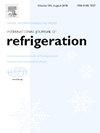纳米制冷剂增强级联制冷系统的热力学评价
IF 3.5
2区 工程技术
Q1 ENGINEERING, MECHANICAL
International Journal of Refrigeration-revue Internationale Du Froid
Pub Date : 2025-07-09
DOI:10.1016/j.ijrefrig.2025.07.009
引用次数: 0
摘要
本文研究了不同制冷剂下,纳米ZrO₂和TiO₂对串级制冷循环(CRC)的热力学性能。该分析使用工程方程求解器(EES)进行,检查了关键性能参数,如性能系数(COP)、火用效率、火用破坏和压缩机工作。研究结果表明,纳米制冷剂提高了能源效率,其中R600的COP和火用效率最高,而R507a的最低。结果表明,ZrO2纳米制冷剂的COP和总火用效率均优于TiO2纳米制冷剂。此外,该研究还强调了低全球变暖潜势(GWP)制冷剂与纳米颗粒结合在一起提高制冷性能的潜力。这些发现为纳米流体在crc中应用的可行性提供了见解,并建议未来的实验研究来验证理论结果。本文章由计算机程序翻译,如有差异,请以英文原文为准。
Thermodynamic evaluation of nanorefrigerant-enhanced cascade refrigeration system
This study investigates the thermodynamic performance of a cascade refrigeration cycle (CRC) enhanced with ZrO₂ and TiO₂ nanoparticles using various refrigerants. The analysis, conducted using the Engineering Equation Solver (EES), examines key performance parameters such as the coefficient of performance (COP), exergy efficiency, exergy destruction, and compressor work. The findings suggest that nanorefrigerants enhance energy efficiency, with R600 demonstrating the highest COP and exergy efficiency, while R507a exhibits the lowest. It has been demonstrated that the COP and overall exergy efficiency of nano refrigerants with ZrO2 nanoparticles exceed those of TiO2. Additionally, the study highlights the potential of low-global-warming-potential (GWP) refrigerants combined with nanoparticles for enhancing refrigeration performance. The findings provide insights into the viability of nanofluid applications in CRCs and suggest future experimental research to validate the theoretical results.
求助全文
通过发布文献求助,成功后即可免费获取论文全文。
去求助
来源期刊
CiteScore
7.30
自引率
12.80%
发文量
363
审稿时长
3.7 months
期刊介绍:
The International Journal of Refrigeration is published for the International Institute of Refrigeration (IIR) by Elsevier. It is essential reading for all those wishing to keep abreast of research and industrial news in refrigeration, air conditioning and associated fields. This is particularly important in these times of rapid introduction of alternative refrigerants and the emergence of new technology. The journal has published special issues on alternative refrigerants and novel topics in the field of boiling, condensation, heat pumps, food refrigeration, carbon dioxide, ammonia, hydrocarbons, magnetic refrigeration at room temperature, sorptive cooling, phase change materials and slurries, ejector technology, compressors, and solar cooling.
As well as original research papers the International Journal of Refrigeration also includes review articles, papers presented at IIR conferences, short reports and letters describing preliminary results and experimental details, and letters to the Editor on recent areas of discussion and controversy. Other features include forthcoming events, conference reports and book reviews.
Papers are published in either English or French with the IIR news section in both languages.

 求助内容:
求助内容: 应助结果提醒方式:
应助结果提醒方式:


